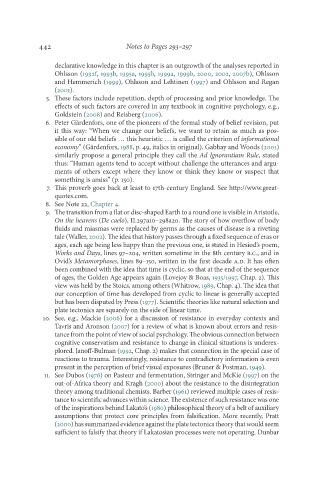Page 459 - Deep Learning
P. 459
442 Notes to Pages 293–297
declarative knowledge in this chapter is an outgrowth of the analyses reported in
Ohlsson (1992f, 1993b, 1995a, 1995b, 1999a, 1999b, 2000, 2002, 2007b), Ohlsson
and Hemmerich (1999), Ohlsson and Lehtinen (1997) and Ohlsson and Regan
(2001).
5. These factors include repetition, depth of processing and prior knowledge. The
effects of such factors are covered in any textbook in cognitive psychology, e.g.,
Goldstein (2008) and Reisberg (2006).
6. Peter Gärdenfors, one of the pioneers of the formal study of belief revision, put
it this way: “When we change our beliefs, we want to retain as much as pos-
sible of our old beliefs … this heuristic … is called the criterion of informational
economy” (Gärdenfors, 1988, p. 49, italics in original). Gabbay and Woods (2001)
similarly propose a general principle they call the Ad Ignorantiam Rule, stated
thus: “Human agents tend to accept without challenge the utterances and argu-
ments of others except where they know or think they know or suspect that
something is amiss” (p. 150).
7. This proverb goes back at least to 17th-century England. See http://www.great-
quotes.com.
8. See Note 22, Chapter 4.
9. The transition from a flat or disc-shaped Earth to a round one is visible in Aristotle,
On the heavens (De caelo), II.297a10–298a20. The story of how overflow of body
fluids and miasmas were replaced by germs as the causes of disease is a riveting
tale (Waller, 2002). The idea that history passes through a fixed sequence of eras or
ages, each age being less happy than the previous one, is stated in Hesiod’s poem,
Works and Days, lines 97–204, written sometime in the 8th century b.c., and in
Ovid’s Metamorphoses, lines 89–150, written in the first decade a.d. It has often
been combined with the idea that time is cyclic, so that at the end of the sequence
of ages, the Golden Age appears again (Lovejoy & Boas, 1935/1997, Chap. 2). This
view was held by the Stoics, among others (Whitrow, 1989, Chap. 4). The idea that
our conception of time has developed from cyclic to linear is generally accepted
but has been disputed by Press (1977). Scientific theories like natural selection and
plate tectonics are squarely on the side of linear time.
10. See, e.g., Mackie (2006) for a discussion of resistance in everyday contexts and
Tavris and Aronson (2007) for a review of what is known about errors and resis-
tance from the point of view of social psychology. The obvious connection between
cognitive conservatism and resistance to change in clinical situations is underex-
plored. Janoff-Bulman (1992, Chap. 2) makes that connection in the special case of
reactions to trauma. Interestingly, resistance to contradictory information is even
present in the perception of brief visual exposures (Bruner & Postman, 1949).
11. See Dubos (1976) on Pasteur and fermentation, Stringer and McKie (1997) on the
out-of-Africa theory and Kragh (2000) about the resistance to the disintegration
theory among traditional chemists. Barber (1961) reviewed multiple cases of resis-
tance to scientific advances within science. The existence of such resistance was one
of the inspirations behind Lakato’s (1980) philosophical theory of a belt of auxiliary
assumptions that protect core principles from falsification. More recently, Pratt
(2000) has summarized evidence against the plate tectonics theory that would seem
sufficient to falsify that theory if Lakatosian processes were not operating. Dunbar

